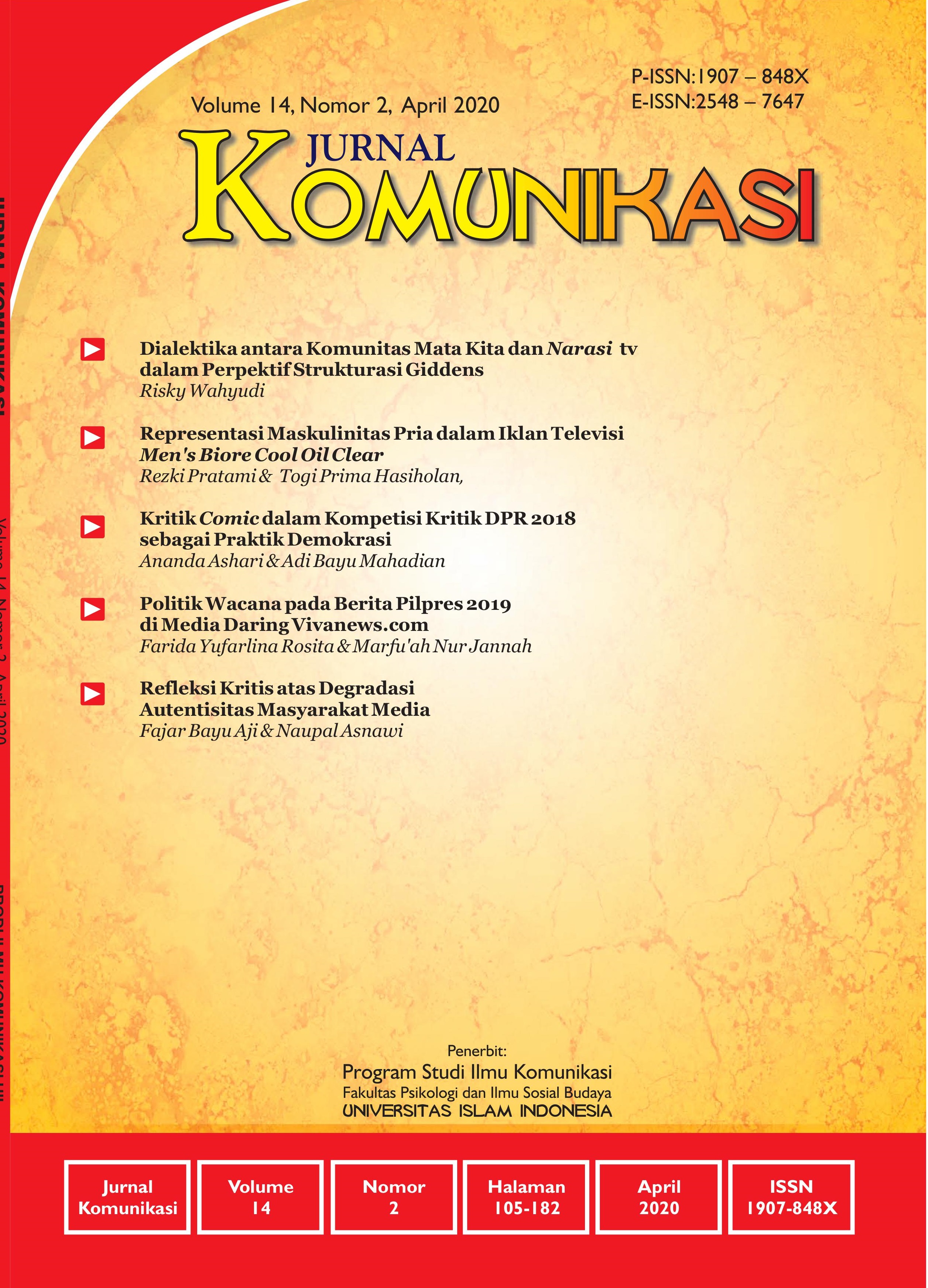Main Article Content
Abstract
The aim of this research is to show that the development of social media in the midst of people's lives cannot be separated from the role of capitalism as an economic global system. Social media, which from the beginning are expected to enable people to access, create, and distribute content without space and time limit. With all the convenience that are presented, social media are actually faced with spectacle problems. Nowadays through social media, capitalism reads the desires of the market and offer it’s products that are claimed to lead one to an ideal life, even though it is only fake news. By using the the critical reflection method and knowledge by acquaintance and description method, the researchers analyze the connection between capitalism, social media, and the degradation of authenticity.
Article Details
References
- Adian, D. G. (2011). Setelah Marxisme: Sejumlah Teori Ideologi Kontemporer. Depok: Penerbit Koekoesan.
- American Society of Plastic Surgeons.
- (2016). New Statistics Reflect the Changing Face of Plastic Surgery. Diambil kembali dari American Society of Plastic Surgeons.
- Bagini, J., & Fosl, P. S. (2010). The Philosopher’s Toolkit: A
- Compendium of Philosophical Concepts and Methods. West Sussex: Wiley-Blackwell.
- Best, S., & Kellner, D. (1999). Debord, Cybersituations, and the
- Interactive Spectacle. Substance, Vol. 18, No. 3, Issue 90: Special Issue: Guy Debord, 129-156.
- Briziarelli, M., & Armano, E. (2017). Introduction: From the Notion of Spectacle to Spectacle 2.0. Dalam M. Briziarelli, & E. Armano, The Spectacle 2.0: Reading Debord in the Context of Digital Capitalism (hal. 15-47). London: University of Westminster Press.
- City, N. (Sutradara). (2017). Jen Selter & Instagram's Most Popular Body Part Models: How To Get Real Followers for Fake Fitness! [Gambar Hidup].
- Debord, G. (1990). Comments on the Society of the Spectacle. London: Verso.
- Debord, G. (2004). The Society of The Spectacle. London: Rebel Press.
- Hawkes, D. (2003). Ideology (Second Edition). New York: Routledge.
- Hess, A. (2018). The Existential Void of the Pop-Up 'Experience'. Diambil kembali dari The New York Times: https://www.nytimes.com/2018/0 9/26/arts/color-factory-museumof-ice-cream-rose-mansion-
- rooms-candytopia.html
- Miller, D. (2016). What is Social Media? Dalam D. Miller, E. Costa, N.
- Haynes, T. McDonald, R. Nicolescu, J. Sinanan, . . . X. Wang,
- How the World Change Social Media (hal. 1-8). London: UCL Press.
- Norval, A. (2012). “Don’t Talk Back!” – The Subjective Conditions of Critical Public Debate. Sage Jornal, vol.40, no.6.
- Urban Dictionary. (2011). Hypebeast. Diambil kembali dari Urban Dictionary:
- https://www.urbandictionary.com/define.php?term=hype%20beast
- Walton, A. G. (2018). New Studies Show Just How Bad Social Media is for Mental Health. . Diambil kembali dari Forbes: https://www.forbes.com/sites/alic egwalton/2018/11/16/newresearch-shows-just-how-badsocial-media-can-be-for-mentalhealth.
- Xemandros, W. S. (2010). Hiperrealitas dalam Iklan Menurut Pemikiran Jean Baudrillard. Depok: Universitas Indonesia.
References
Adian, D. G. (2011). Setelah Marxisme: Sejumlah Teori Ideologi Kontemporer. Depok: Penerbit Koekoesan.
American Society of Plastic Surgeons.
(2016). New Statistics Reflect the Changing Face of Plastic Surgery. Diambil kembali dari American Society of Plastic Surgeons.
Bagini, J., & Fosl, P. S. (2010). The Philosopher’s Toolkit: A
Compendium of Philosophical Concepts and Methods. West Sussex: Wiley-Blackwell.
Best, S., & Kellner, D. (1999). Debord, Cybersituations, and the
Interactive Spectacle. Substance, Vol. 18, No. 3, Issue 90: Special Issue: Guy Debord, 129-156.
Briziarelli, M., & Armano, E. (2017). Introduction: From the Notion of Spectacle to Spectacle 2.0. Dalam M. Briziarelli, & E. Armano, The Spectacle 2.0: Reading Debord in the Context of Digital Capitalism (hal. 15-47). London: University of Westminster Press.
City, N. (Sutradara). (2017). Jen Selter & Instagram's Most Popular Body Part Models: How To Get Real Followers for Fake Fitness! [Gambar Hidup].
Debord, G. (1990). Comments on the Society of the Spectacle. London: Verso.
Debord, G. (2004). The Society of The Spectacle. London: Rebel Press.
Hawkes, D. (2003). Ideology (Second Edition). New York: Routledge.
Hess, A. (2018). The Existential Void of the Pop-Up 'Experience'. Diambil kembali dari The New York Times: https://www.nytimes.com/2018/0 9/26/arts/color-factory-museumof-ice-cream-rose-mansion-
rooms-candytopia.html
Miller, D. (2016). What is Social Media? Dalam D. Miller, E. Costa, N.
Haynes, T. McDonald, R. Nicolescu, J. Sinanan, . . . X. Wang,
How the World Change Social Media (hal. 1-8). London: UCL Press.
Norval, A. (2012). “Don’t Talk Back!” – The Subjective Conditions of Critical Public Debate. Sage Jornal, vol.40, no.6.
Urban Dictionary. (2011). Hypebeast. Diambil kembali dari Urban Dictionary:
https://www.urbandictionary.com/define.php?term=hype%20beast
Walton, A. G. (2018). New Studies Show Just How Bad Social Media is for Mental Health. . Diambil kembali dari Forbes: https://www.forbes.com/sites/alic egwalton/2018/11/16/newresearch-shows-just-how-badsocial-media-can-be-for-mentalhealth.
Xemandros, W. S. (2010). Hiperrealitas dalam Iklan Menurut Pemikiran Jean Baudrillard. Depok: Universitas Indonesia.




